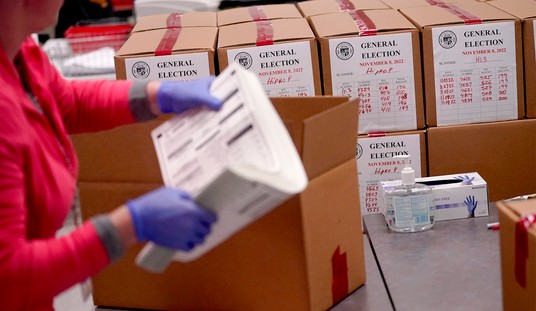In the Aviator, director Martin Scorsese tells the story of Howard Hughes, had perhaps the biography of Howard Hughes been written by Ayn Rand. Hughes is portrayed by Leonardo DiCaprio as obsessively pushing the envelope forward in aviation, breaking both technical and legal barriers to progress.
Hughes’ pursuit of progress runs him into conflict with Pan-American airlines and their servile minion in Congress, Senator Brewster, played by Alan Alda. Brewster seeks to protect Pan American’s trans-Atlantic flight market, and uses the investigative powers of Congress in order to coerce Hughes. Consumers will be better served by a monopoly, Brewster explains, a position that Hughes finds “Un-American.”
Hughes asks Brewster “Do you really want to do this? Do you want to go to war with me?”
Brewster replies:
“It’s not me, Howard. It’s the United States government. We just beat Germany and Japan. Who the hell are you?”
This being a Hollywood movie, of course, our rugged individualist hero prevails, decisively crushing Senator Brewster and Pan-American in dramatic fashion in a Senate hearing showdown. Travelers enjoy the enormous benefits of aviation competition to this day.
Sadly, in the real word, other monopolies have rather more staying power than Pan-Am, including sadly our education laws. A fine line exists between stability and stagnation. In education policy, we have been content to sail well past that line. Our answer to all education problems was to put in more money. In 1960, the average spending per pupil was $375 (around $2300 in inflation adjusted dollars). Today, we spend close to $10,000 per pupil. Even after adjusting for inflation, spending per pupil in the public school system as more than tripled since the first baby-boomers attended schools.
Recommended
Our education problems worsened despite the increased spending. Today, 38 percent of our 4th graders have failed to learn basic reading skills, and around a third of our high school students dropout of high school. As today’s dropouts are largely those students who failed to learn to read in elementary schools, tomorrow’s dropouts are already in the pipeline.
Andrew Coulson recently noted that the last great innovation to transform American classroom instruction came with the invention of the chalkboard in 1801. Consider this level of stasis in comparison to the computer industry. Today, you could literally throw a dart in the computer section of a department store and have it land on a personal computer which is more powerful and cheaper than what was available two years ago. By comparison, the school system continues to plod along, always spending more but often producing less.
The productivity of spending in our public education system has collapsed over the past half century. We spend beyond the dreams of avarice for a public school superintendent of the 1960s, but we don’t produce better results. For decades, we have been throwing money at our public schools and failing to notice that students were failing to benefit.
Fortunately, this status-quo will not endure forever. A growing consensus on both left and right recognizes that our most disadvantaged students suffer most from the shortcomings of our schools. Children relying most heavily on schools to prepare them for the future are tragically the most likely to be shortchanged.
Our nation’s poorest families cannot afford to buy into high-quality suburban school districts, or to pay private school tuition in addition to their school taxes. Policymakers from both parties have therefore increasingly embraced policies creating options for parents. Nationwide, nearly a fourth of K-12 students won't be attending their neighborhood public schools this fall, opting instead for an array of public and private options- including magnet, charter, private and home schooling. For many, especially for inner-city children, however, these options remain far too scarce and this momentum must accelerate.
Charter school operators such as KIPP, Yes Academies and Amistad have proven definitively that low-income inner city children can learn at an accelerated pace, and can even outperform our complacent suburban schools and attend elite universities. These innovators face huge political and practical obstacles in making these schools more widely available, but don’t bet against them. Already, they have settled the question of whether we must settle for today’s failed status quo: we don’t. Our students can learn. We adults simply have to learn how to follow the example of those who are getting the job done.
Our students need a market for K-12 schools. The market mechanism rewards success and either improves or eliminates failure. This has been sorely lacking in the past, and will be increasingly beneficial in the future. The biggest winners will be those suffering most under the status-quo.
New technologies and practices, self-paced instruction and data-based merit pay for instructors, may hold enormous promise. Before the current era of choice based reforms, they didn’t fit the 19th Century/unionized model of schooling, so they weren’t seriously attempted. Bypassing bureaucracy, a new generation has begun to offer their innovative schools directly to parents. Some have already succeeded brilliantly. Some states have been much keener than others to allow this process. Expect the laggards to fall in line eventually. We can hardly continue to cower in fear that someone somewhere might open a bad school when, in reality, we are surrounded by them now.
A market system will embrace and replicate reforms which work, and discard those that fail to produce. A top-down political system has failed to perform this task. Where bureaucrats and politicians have failed miserably, however, a market of parents pursuing the interests of their children will succeed in driving progress.
We cannot feel satisfied with a system that watches helplessly as a third of pupils drop out before graduation each year. We can do much better. The key lies in matching disadvantaged students with high quality teachers and school leaders. Parental choice programs help to achieve this by providing new education delivery methods.
While there will be enemies to fight this progress, but they won’t prevail. America is rousing itself from a century long slumber of stagnant schooling practices. We have nothing to lose and everything to gain from the coming education renaissance, so long as we have the wisdom to embrace it.

























Join the conversation as a VIP Member